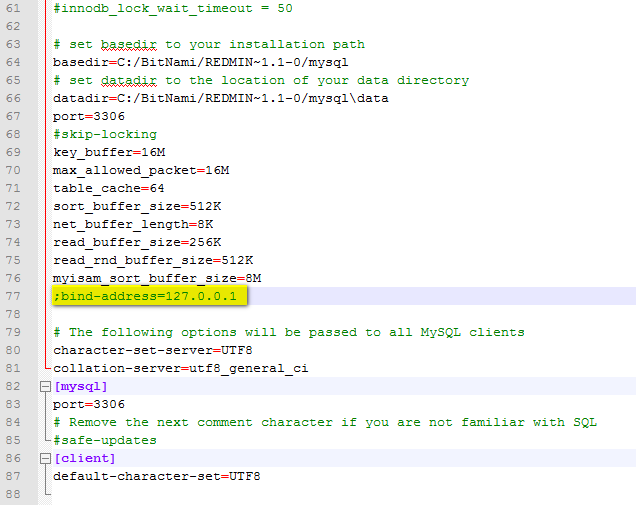
- BITNAMI REDMINE MYSQL ROOT PASSWORD HOW TO
- BITNAMI REDMINE MYSQL ROOT PASSWORD MAC OS X
- BITNAMI REDMINE MYSQL ROOT PASSWORD UPDATE
- BITNAMI REDMINE MYSQL ROOT PASSWORD WINDOWS
BITNAMI REDMINE MYSQL ROOT PASSWORD UPDATE
MySQL 5.6.x or earlier: UPDATE er SET Password=PASSWORD('NEW_PASSWORD') WHERE User='root' MySQL 5.7.x or MySQL 8.x: ALTER USER IDENTIFIED BY 'NEW_PASSWORD'
BITNAMI REDMINE MYSQL ROOT PASSWORD HOW TO
Learn how to start or stop the services.Ĭheck the MySQL version: installdir\mysql\bin\mysqladmin.exe -versionĬreate a file named mysql-init.txt with the content shown below depending on your MySQL version (replace NEW_PASSWORD with the password you wish to use): Stop the MySQL server using the graphic manager tool. Restart the MySQL server: $ sudo installdir/ctlscript.sh restart mysql If your stack ships an older version of MySQL, use this command: $ sudo installdir/mysql/bin/mysqld_safe -pid-file=installdir/mysql/data/mysqld.pid -datadir=installdir/mysql/data -init-file=/tmp/mysql-init 2> /dev/null & If your stack ships MySQL v8.x, use this command: $ sudo installdir/mysql/bin/mysqld_safe -pid-file=installdir/mysql/data/mysqld.pid -datadir=installdir/mysql/data -init-file=/tmp/mysql-init -lower_case_table_names=1 2> /dev/null & Stop the MySQL server: $ sudo installdir/ctlscript.sh stop mysql TIP: Check the MySQL version with the command installdir/mysql/bin/mysqladmin -version or installdir/mysql/bin/mysqld -version If your stack ships MySQL v5.6.x or earlier, use this content: UPDATE er SET Password=PASSWORD('NEW_PASSWORD') WHERE User='root' If your stack ships MySQL v5.7.x, use this content: ALTER USER IDENTIFIED BY 'NEW_PASSWORD' If your stack ships MySQL v8.x, use this content: ALTER USER IDENTIFIED BY 'NEW_PASSWORD' ĪLTER USER IDENTIFIED BY 'NEW_PASSWORD' If you don’t remember your MySQL root password, you can follow the steps below to reset it to a new value:Ĭreate a file in /tmp/mysql-init with the content shown below (replace NEW_PASSWORD with the password you wish to use).
BITNAMI REDMINE MYSQL ROOT PASSWORD MAC OS X
Reset the MySQL root password Linux and Mac OS X installdir\mysql\bin\mysqladmin.exe -p -u root password NEW_PASSWORD Replace the NEW_PASSWORD placeholder with the actual password you wish to set. You can modify the MySQL password using the following command at the shell prompt.

$ installdir/mysql/bin/mysqladmin -p -u root password NEW_PASSWORD NOTE: When setting a new password, avoid the use of special characters or quotes, as this can sometimes cause issues when accessing the database through shell scripts. If present, the installer uses MariaDB and if not, it uses MySQL.ĭepending on which database server (MySQL or MariaDB) is used by the installation, use the appropriate guides in our documentation for database-related operations.

BITNAMI REDMINE MYSQL ROOT PASSWORD WINDOWS
Windows native installer users can identify which database server is used in the stack by checking for the presence of the installdir/mariadb directory. Linux and macOS native installer users can identify which database server is used in the stack by running the command below: $ test -d installdir/mariadb & echo "MariaDB" || echo "MySQL"


On account of these changes, the file paths and commands stated in this guide may change depending on whether your Bitnami stack uses MySQL or MariaDB. NOTE: We are in the process of modifying the configuration for many Bitnami stacks. Learn more about the Bitnami stack environment and about OS X VMs. On OS X VMs, the installation directory is /opt/bitnami and OS X VM users can click the “Open Terminal” button to run commands. Before running the commands shown on this page, you should load the Bitnami stack environment by executing the installdir/use_APPNAME script (Linux and MacOS) or by clicking the shortcut in the Start Menu under “Start -> Bitnami APPNAME Stack -> Application console” (Windows).


 0 kommentar(er)
0 kommentar(er)
